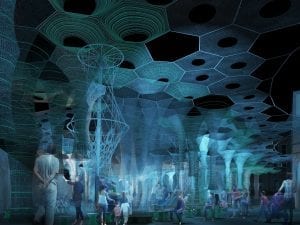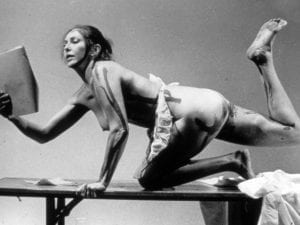First shown at the Sharjah Biennial in March this year, and currently on view at MoMA PS1, New York, Korean artist IM Hueng-soon’s video installation titled Reincarnation is a deeply ponderous work on the burden of grief. Contrary to one’s expectations of a rebirth, as the title might imply, the work serves to rekindle the unacknowledged suffering of older Korean women who were the designated entertainers for soldiers from South Korea during the Vietnam War, and mothers who lost their sons during the Iran-Iraq war.
Initially, IM’s projection of two different videos on opposite walls at the same time comes as a surprise. One has to grapple with the rhythm of turning one’s head frequently from side to side, and adjust to the simultaneous infiltration of images and norms from two very different cultures and people. Although we are informed from the wall text that many of the Korean female entertainers during the Vietnam War eventually settled in Iran in the 1970s for what was then considered to be better economic prospects, the connection between the two disparate cultures in Iran and Vietnam is made evident from the women’s collective suffering in the aftermath of war.
The effectiveness of IM’s video installation is embedded in his treatment of grief. With minimal reenactment of the circumstances, the artist juxtaposes two distinctly opposed ways of expressing remorse that reinforces the depth of the women’s experiences. While the Iranian mothers’ seemingly excessive, almost deranged vocalisation of trauma is manifested through the imagined return of their sons that “mediates the gap between life and death,” as Richard Armstrong points out in his book Mourning Films, the quiet stoicism of the aged Korean women in Vietnam echoes their unfathomable suppression of sorrow. As the sound track from the Iranian women’s shrieking lingers and overlaps with the resignation of the ill-fated Koreans, the audience is drawn into a collective consciousness of empathy for their situation.
IM dexterously interweaves the interaction between the women’s inner states and outer realities so that there is a strong correlation between their physical condition and psychological space. Deep creases like trenches on a war field mar the faces of the Korean women—some of who are incapacitated by illnesses and speak of being haunted by dark looming ghostly figures. Memories of horror and subjugation are theirs alone to endure and tell. Bent over with age and grief, women from both narratives visit tombstones as their allegiance to the dead.
Landscapes and the surrounding environment are important signifiers of the women’s plight for IM. Homes in Iran become shrines of loss—and absence is endured through childhood knick-knacks, photographs, and memorabilia of the deceased. Historical footage of bereaved mothers in public processions lamenting the death of their martyred sons unfold, as images of the dry punishing desert in the Middle East erode and bury memories of the dead. The sea features as the eternal soother of defeat, and a reminder of the relentlessness of life. Realisation and then the acceptance of loss is conveyed through a plaque that reads “monument of hate against the South Korean army” in the Go Dai village in Vietnam where innocent civilians were mercilessly slaughtered by South Korean soldiers.
Without being over sentimental or alienating, IM’s insightful video installation sparks compassion and corrals support for these unknown tales. His ongoing series of works on the impact of war on an older generation of Koreans includes a segment on the life of Korean women settled in Iran. Hueng-soon speaks of the motivation behind the film in interview: “Reincarnation does not seek to signify the emergence of an unprecedented phenomenon, but suggests a way of remembering the deceased and the suffering, as well as restoring conscience, morality, empathy, and justice.”
Bansie Vasvani
IM Heung-soon, Reincarnation, until 7 September, MoMA PS1, 22-25 Jackson Ave, Long Island City, New York.
Learn more at momaps1.org.
Follow us on Twitter @AestheticaMag for the latest news in contemporary art and culture.
Credits
1. IM Heung-soon, Reincarnation, 2015. Two-channel HD video; color, sound 23:44 min. Courtesy of the artist, Sharjah Art Foundation and MoMA PS1. Photo by Pablo Enriquez.





